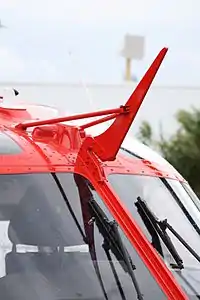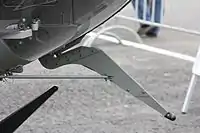Wire strike protection system
The wire strike protection system (WSPS) is a mechanical wire cutter designed to mitigate the risk of wire strikes while flying helicopters at low-level, particularly military helicopters and those civilian helicopters involved in agricultural work.

The system is mounted around the front of many American military helicopters,[1] and some civilian helicopters.
History


During the six-year period covering calendar years 1974 through 1979, wire strike accidents accounted for a significant share of United States Army Aviation peacetime mishaps, accounting for 8% of aircraft damage, 6% of aircraft-related injuries, and 16% of aircraft-related fatalities.[2]:9 Over a similar period covering the ten years between 1970 and 1979, 208 civil helicopters were involved in wire strike accidents. Of these, 88 were destroyed (42%) and 37 (11%) of the 331 people involved were killed.[3]:5;7 The most common cause of civil helicopter aerial accidents between 1975 and 1977 was striking wires and poles.[3]:1
Bristol Aerospace developed a WSPS qualified for the Bell OH-58 Kiowa under contract to the Canadian Armed Forces in May 1979.[2]:9 Nelson Chan is credited with inventing WSPS, according to the patents granted in 1980.[4][5] Bristol staged a series of 52 tests of the WSPS by mounting it on the fuselage of a wrecked Kiowa; the fuselage was loaded onto a flatbed truck and driven into wires at speeds ranging from 15 to 60 mph (13 to 52 kn; 24 to 97 km/h), yaw angles ranging from 0 to 45°, and a variety of cables that were typically used in overhead power and telecommunication transmission lines, including a 3⁄8 in (9.5 mm) 7-strand steel cable with a tensile strength exceeding 10,000 lb (4,500 kg).[2]:9–10
Because the Bristol testing did not determine the effectiveness of the lower fuselage-mounted cutter, and was a ground-based test that did not evaluate how a wire strike with the cutter would affect aircraft attitude during flight, the United States Army Research Laboratory conducted supplemental pendulum swing tests at the Impact Dynamics Research Facility located at Langley Research Center with a Kiowa in October 1979.[2]:11 An additional deflector to protect the skids, landing gear, and tail boom (including the rotor and vertical stabilizer) was also tested, but was found to be ineffective.[2]:11;15–19;41
During the Langley tests, an OH-58 was attached to the end of a 196-foot (60 m) long cable, pulled back, and released to swing through wires mounted horizontally at a height of approximately 22 feet (6.7 m).[2]:14 Similar pendulum tests were subsequently performed at Langley for Bell UH-1H[6] and AH-1S helicopters in 1981 and 1982.[1]
All small to medium [lower-alpha 1] United States Army helicopters were fitted with WSPS in a retrofit programme that was completed in 1992.[7] Between 1996 and 2002 the US Army had no fatal wire strike accidents.[7] In civil helicopter operations, wire cutters were thought to be most effective for agricultural flights.[3]:37–38 Of the 208 wire strike accidents in the 1970s, almost half could have been avoided with wire cutters and other recommended mechanical upgrades.[3]:45
Description
.jpg.webp)
The WSPS developed by Bristol, which is typical of most cable cutters today, consists of a roof-mounted cutter, a lower cutter fitted to the fuselage,[lower-alpha 2] and a deflector fitted to the middle of the windshield to guide the cable into the cutters.[2]:9 [7] Sometimes a windshield wiper protector frame is used to stop the cables from catching on wiper motor shafts.[8] As installed, the OH-58 WSPS developed by Bristol weighs 16.3 lb (7.4 kg) and requires 40 man-hours to install.[2]:15
Wire Strike Protection System is a registered trademark of Magellan Aerospace, the parent company of Bristol via acquisition.[9] Dart Aerospace markets an equivalent apparatus under the name Cable Cutter System.[10] Cable cutting systems to protect helicopters have been developed by other manufacturers, including MD Helicopters (1981),[11] Custom Air (1987),[12] Airbus Helicopters (2008[13] and 2011),[14] and Bell Helicopter (2014).[15] Another invention aims to protect the rotor by equipping the control rods with cutting edges.[16]
The system is effective when the helicopter strikes the wires at angle of less than 90 degrees and at speeds more than 30 knots (35 mph; 56 km/h).[7] The system is designed to cut a 3⁄8-inch (9.5 mm) steel cable with a breaking strength of 12,000 lb (5,400 kg).[7]
See also
References
- Burrows, LeRoy T. (December 1982). Verification Testing of an AH-1S Wire Strike Protection System (WSPS) (PDF) (Report). US Army Aviation Research and Development Command (AVRADCOM). Retrieved 2 April 2020.
- Burrows, LeRoy T. (June 1980). Investigation of Helicopter Wire Strike Protection Concepts (PDF) (Report). US Army AVRADCOM. Retrieved 2 April 2020.
- Tuomela, Clyde H.; Brennan, Mark F. (October 1980). Civil Helicopter Wire Strike Assessment Study (PDF) (Report). 1. National Aeronautics and Space Administration. Retrieved 2 April 2020.
- CA Grant 1079182A, Nelson Chan, "Cable-cutting device", published 10 June 1980, assigned to Canada Minister of National Defence
- US Grant 4215833A, Nelson Chan, "Cable-cutting device", published 5 August 1980, assigned to Canada Minister of National Defence
- Burrows, LeRoy T. (November 1982). Verification Testing of a UH-1 Wire Strike Protection System (WSPS) (PDF) (Report). US Army AVRADCOM. Retrieved 2 April 2020.
- Nagaraj, Vengalattore T.; Chopra, Inderjit (September 2018). Safety Study of Wire Strike Devices Installed on Civil and Military Helicopters (PDF) (Report). Air Traffic Organization, Operations Planning Office of Aviation Research and Development, Federal Aviation Administration, United States Department of Transportation. Retrieved 2 April 2020.
- WSPS
- "Wire Strike Protection System™" (PDF). Magellan Aerospace. Retrieved 2 April 2020.
- "Cable Cutters". DART Aerospace. Retrieved 2 April 2020.
- US Grant 4407467A, Charles F. Emigh & Morris Goldin, "Tactical wire-cutter system for helicopters", published 4 October 1983, assigned to McDonnell Douglas Helicopter Co
- US Grant 4826103A, James M. McKown, "Active cable-cutting assembly for aircraft", published 2 May 1989, assigned to Custom Air Inc.
- FR Grant 2935956B1, Gerald Claeys, "Dispositif sectionneur de cables", published 2 May 1989, assigned to Airbus Helicopters SAS
- FR Grant 2982844B1, Marc Denante & Lacroix Pierre Prudhomme, "Dispositif sectionneur de cables, et aeronef", published 14 March 2014, assigned to Airbus Helicopters SAS
- US Grant 9725165B2, Michael Smith; Chen-Ho Tho & Anand Kumar Marimuthu, "Cable cutter system", published 8 August 2017, assigned to Bell Helicopter Textron Inc.
- US Grant 5286170A, William W. Brannon, "Helicopter wire strike cutter", published 15 February 1994
External links
- www.helicopterpage.com - WSPS (How Helicopters Work)
- Wire Strike Accidents in General Aviation: Data Analysis 1994 to 2004 – Page 33
- Wire Strike Protection System, MDHS 500 Maintenance Manual
- Magellan Aerospace Announces New Bell Helicopter Wire Strike Protection System Development
- Wire Strike Protection System (WSPS) - The Cutting Edge of Helicopter Safety on YouTube. Marketing video from Magellan/Bristol that includes development of WSPS. Clips from flatbed and pendulum testing are shown.
- Un hélicoptère percute des lignes de haute tension on YouTube. Video of a helicopter wire strike that occurred during a rescue exercise. The helicopter was equipped with a WSPS.
- Prior art
- DK Grant 38811C, Jacob Christian Hansen-Ellehammer, "Flyvemaskine", published 29 May 1928, assigned to Fabrikant af Motorer og Motorkøretøjer
- DE Grant 739409C, Georg Baierle & Gustav Leutner, "An einem Flugzeug angebrachte Vorrichtung zum Zerstoeren von Sperrdraehten", published 24 September 1943
- US Grant 2335952A, James Martin, "Cable cutting device for use on aircraft", published 7 December 1943
- AU Grant 6573374A, William Ronald Smith & Sydney Langford Howlett, "Improvements in and relating to cable specification or other line cutting devices", published 21 August 1975, assigned to Commonwealth of Australia

